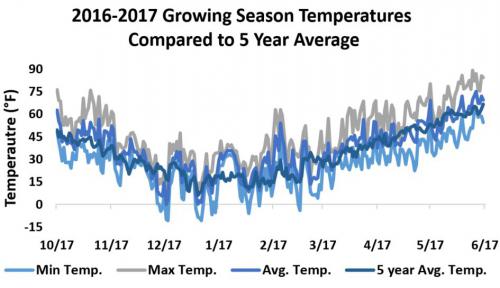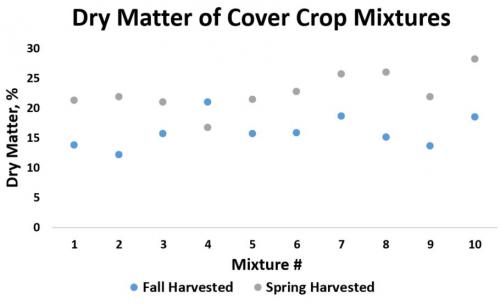Cover crop mixture trial in Michigan’s Upper Peninsula — Part 1: Yield
Michigan State University Extension staff continue to explore cover crop specie options that grow well in northern climates.

Very little practical research data exists on cover crop mixture success in Michigan’s Upper Peninsula, so a team of Michigan State University Extension researchers recently developed a project to help inform cover crop implementation in the region. Funding through Project GREEEN allowed researchers from the Upper Peninsula Research and Extension Center to collaborate with Steve Brock Diary Farm to establish replicated cover crop plots with 10 different mixtures (Table 2).
Planting took place Aug. 30, 2016, and data was collected Oct. 17, 2016, and June 16, 2017. Cover crop mixtures were evaluated on yield and nutrient content. This article will discuss the results of the cover crop mixture yields and weather conditions during the trial.
Weather
Average temperature and precipitation during the trial has been summarized in Table 1 and Figure 1. Average rainfall in 2016 – 2017 was greater compared to the last four years. The spring of 2017 did cause some challenging field conditions, pushing our spring harvesting time back a couple weeks.
| Table 1. Summary of average rainfall Oct. 17 – June 16 for five years. Data from 2016 – 2017 is the total rainfall accrued during this trial. | ||
|---|---|---|
| Year | Rainfall total (in.) | Hours with rainfall |
| 2016-2017 | 19.55 | 478 |
| 2015-2016 | 17.52 | 403 |
| 2014-2015 | 14.77 | 358 |
| 2013-2014 | 15.39 | 302 |
| 2012-2013 | 12.78 | 342 |
| 5 yr. avg. | 16 | 377 |
Figure 1. Temperature summary from Oct. 17, 2016, to June 16, 2017 compared to a five-year average temperature.
Results
When considering harvesting cover crops and storing them for feed purposes, moisture content at harvest is important for storage quality and length. Microbial activity slows at less than 22 percent moisture content and becomes stagnant at 18 percent, according to research by Shah and Darr in 2014. Having material harvested that is less than 22 percent moisture would be ideal to prevent degradation of the nutrient content and quality during storage if a dry-bale system is used.
On average, cover crops harvested in fall were wetter (16 percent dry matter) compared to spring harvest (23 percent dry matter) (Fig. 2, p<0.05). Cisco Rye harvested in spring yielded 1 ton per acre and was the driest cover crop at 28 percent dry matter. Due to the moisture content, dry-bale storage would not be recommended, but an ensiled chop harvest system would work.
On average, the greatest amount of yield was realized in fall (0.95 dry matter ton per acre) compared to a spring harvest (0.70 dry matter ton per acre) (Fig. 3, p<0.05). Mixture 4 (80 percent Triticale, 10 percent crimson clover, 10 percent Tillage Radish) has the highest yield (fall, 1.56 dry matter ton per acre), although was statistically not significant.
Figure 2. Dry matter of cover crop mixtures by harvest time (fall or spring) for each mixture type (p<0.05).
Figure 3. Yield of cover crop mixtures by harvest time (fall or spring) for each mixture type (p<0.10).
For questions related to this research project, please contact Monica Jean, MSU Extension field crops educator, at 906-786-3032 or atkinmon@anr.msu.edu, or Ashley McFarland, Upper Peninsula Research and Extension coordinator, at 906-439-5176 or ashleymc@msu.edu.
For more information on cover crops, visit the MSU Extension Cover Crops or Midwest Cover Crop Council websites.



 Print
Print Email
Email







